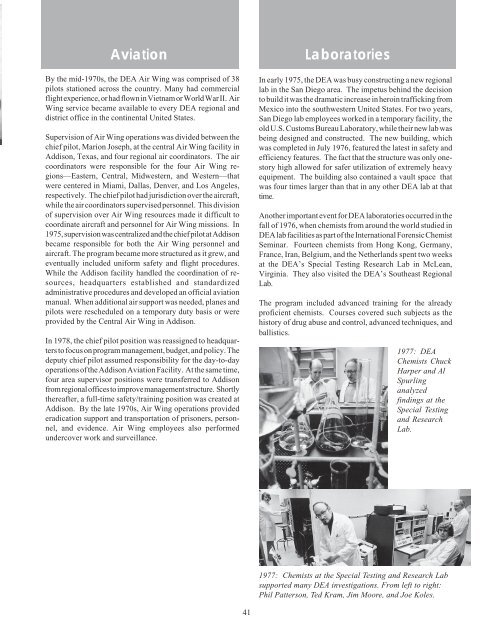Download This File - The Free Information Society
Download This File - The Free Information Society
Download This File - The Free Information Society
You also want an ePaper? Increase the reach of your titles
YUMPU automatically turns print PDFs into web optimized ePapers that Google loves.
Aviation Laboratories<br />
By the mid-1970s, the DEA Air Wing was comprised of 38<br />
pilots stationed across the country. Many had commercial<br />
flight experience, or had flown in Vietnam or World War II. Air<br />
Wing service became available to every DEA regional and<br />
district office in the continental United States.<br />
Supervision of Air Wing operations was divided between the<br />
chief pilot, Marion Joseph, at the central Air Wing facility in<br />
Addison, Texas, and four regional air coordinators. <strong>The</strong> air<br />
coordinators were responsible for the four Air Wing regions—Eastern,<br />
Central, Midwestern, and Western—that<br />
were centered in Miami, Dallas, Denver, and Los Angeles,<br />
respectively. <strong>The</strong> chief pilot had jurisdiction over the aircraft,<br />
while the air coordinators supervised personnel. <strong>This</strong> division<br />
of supervision over Air Wing resources made it difficult to<br />
coordinate aircraft and personnel for Air Wing missions. In<br />
1975, supervision was centralized and the chief pilot at Addison<br />
became responsible for both the Air Wing personnel and<br />
aircraft. <strong>The</strong> program became more structured as it grew, and<br />
eventually included uniform safety and flight procedures.<br />
While the Addison facility handled the coordination of resources,<br />
headquarters established and standardized<br />
administrative procedures and developed an official aviation<br />
manual. When additional air support was needed, planes and<br />
pilots were rescheduled on a temporary duty basis or were<br />
provided by the Central Air Wing in Addison.<br />
In 1978, the chief pilot position was reassigned to headquarters<br />
to focus on program management, budget, and policy. <strong>The</strong><br />
deputy chief pilot assumed responsibility for the day-to-day<br />
operations of the Addison Aviation Facility. At the same time,<br />
four area supervisor positions were transferred to Addison<br />
from regional offices to improve management structure. Shortly<br />
thereafter, a full-time safety/training position was created at<br />
Addison. By the late 1970s, Air Wing operations provided<br />
eradication support and transportation of prisoners, personnel,<br />
and evidence. Air Wing employees also performed<br />
undercover work and surveillance.<br />
41<br />
In early 1975, the DEA was busy constructing a new regional<br />
lab in the San Diego area. <strong>The</strong> impetus behind the decision<br />
to build it was the dramatic increase in heroin trafficking from<br />
Mexico into the southwestern United States. For two years,<br />
San Diego lab employees worked in a temporary facility, the<br />
old U.S. Customs Bureau Laboratory, while their new lab was<br />
being designed and constructed. <strong>The</strong> new building, which<br />
was completed in July 1976, featured the latest in safety and<br />
efficiency features. <strong>The</strong> fact that the structure was only onestory<br />
high allowed for safer utilization of extremely heavy<br />
equipment. <strong>The</strong> building also contained a vault space that<br />
was four times larger than that in any other DEA lab at that<br />
time.<br />
Another important event for DEA laboratories occurred in the<br />
fall of 1976, when chemists from around the world studied in<br />
DEA lab facilities as part of the International Forensic Chemist<br />
Seminar. Fourteen chemists from Hong Kong, Germany,<br />
France, Iran, Belgium, and the Netherlands spent two weeks<br />
at the DEA’s Special Testing Research Lab in McLean,<br />
Virginia. <strong>The</strong>y also visited the DEA’s Southeast Regional<br />
Lab.<br />
<strong>The</strong> program included advanced training for the already<br />
proficient chemists. Courses covered such subjects as the<br />
history of drug abuse and control, advanced techniques, and<br />
ballistics.<br />
1977: DEA<br />
Chemists Chuck<br />
Harper and Al<br />
Spurling<br />
analyzed<br />
findings at the<br />
Special Testing<br />
and Research<br />
Lab.<br />
1977: Chemists at the Special Testing and Research Lab<br />
supported many DEA investigations. From left to right:<br />
Phil Patterson, Ted Kram, Jim Moore, and Joe Koles.

















